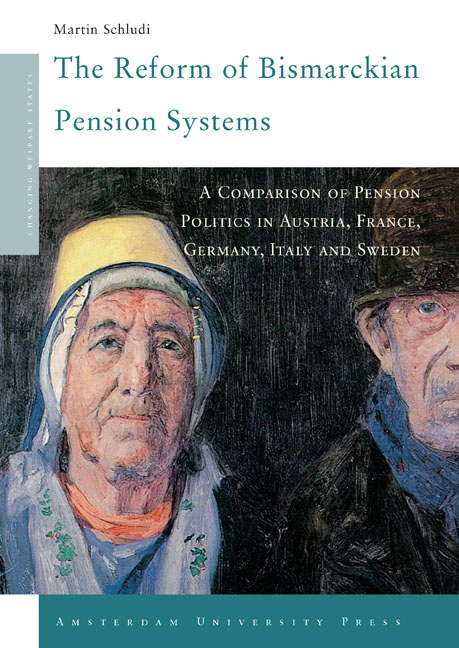 The Reform of Bismarckian Pension Systems
The Reform of Bismarckian Pension Systems Book contents
- Frontmatter
- Contents
- List of Tables/List of Figures
- Acknowledgements
- Introduction
- 1 The Need for Pension Reform:A Problem-Oriented Perspective
- 2 An Empirical Overview of Policy Change in Bismarckian Pension Regimes
- 3 The Politics of Pension Reform:An Actor-Centred Explanatory Framework
- 4 Sweden:Policy-Oriented Bargaining
- 5 Italy:Corporatist Concertation in the Shadow of EMU
- 6 Germany:From Consensus To Conflict
- 7 Austria:Reform Blockage by the Trade Unions
- 8 France:Adverse Prerequisites for a Pension Consensus
- 9 Conclusion
- Appendix I Summary Description of Retirement Systems (1986)
- Appendix II Chronology of National Pension Reforms
- Appendix III Glossary of Terms
- Notes
- Bibliography
- Index
8 - France:Adverse Prerequisites for a Pension Consensus
Published online by Cambridge University Press: 24 January 2021
- Frontmatter
- Contents
- List of Tables/List of Figures
- Acknowledgements
- Introduction
- 1 The Need for Pension Reform:A Problem-Oriented Perspective
- 2 An Empirical Overview of Policy Change in Bismarckian Pension Regimes
- 3 The Politics of Pension Reform:An Actor-Centred Explanatory Framework
- 4 Sweden:Policy-Oriented Bargaining
- 5 Italy:Corporatist Concertation in the Shadow of EMU
- 6 Germany:From Consensus To Conflict
- 7 Austria:Reform Blockage by the Trade Unions
- 8 France:Adverse Prerequisites for a Pension Consensus
- 9 Conclusion
- Appendix I Summary Description of Retirement Systems (1986)
- Appendix II Chronology of National Pension Reforms
- Appendix III Glossary of Terms
- Notes
- Bibliography
- Index
Summary
Key features of the French pension system in the late 1980s
The French pension system comprises a large number of pay-as-you-go financed and categorically fragmented schemes with privately funded schemes of only minimal importance. Private sector employees (65% of the insured population) are covered by the régime général. For public sector employees (20%) and the self-employed (12%), a number of separate schemes exist side by side and are organised by employer and profession. Retirement age, contribution rates, and calculation of benefits vary greatly from one scheme to another (Bonoli 2000). Private sector pensions are essentially based on a two-tiered structure with a number of compulsory occupational schemes complementing the general scheme. Public sector pensions, by contrast, are usually provided in one tier (for an overview see table 8.1).
The régime général is financed by employers’ and employees’ contributions (8.2% and 6.4%, respectively, up to a certain contribution ceiling). A total of 37.5 contribution years are necessary to receive a full pension corresponding to 50% of the salary base earned over the last 10 years. The retirement age for both genders is 60 years. Apart from contributory pensions, the general regime also provides means-tested benefits (minimum viellesse) for elderly people with insufficient resources.
As already noted, French employees in the private sector are also compulsorily covered by complementary schemes topping up the benefits out of the general scheme. The ARRCO (Association des régimes de retraites complémentaires) scheme covers virtually all private sector employees, whereas agirc (Association générale des institutions de retraite des cadres) provides a supplementary benefit for executives only. For an average worker, the combined replacement rate from the general and the complementary scheme roughly corresponds to 70% of previous wages. However, while the complementary schemes operate on a pay-as-you-go basis, they are (in contrast to the general scheme) of the defined-contribution type. Hence, there is no fixed replacement rate and benefits are adjusted downward whenever contributions fall below the level needed to maintain the scheme's fiscal equilibrium. In contrast to the general scheme, ARRCO and AGIRC were established through collective agreements and are exclusively managed by the social partners (Gillion et al. 2000).
- Type
- Chapter
- Information
- The Reform of Bismarckian Pension SystemsA Comparison of Pension Politics in Austria, France, Germany, Italy and Sweden, pp. 191 - 218Publisher: Amsterdam University PressPrint publication year: 2005
